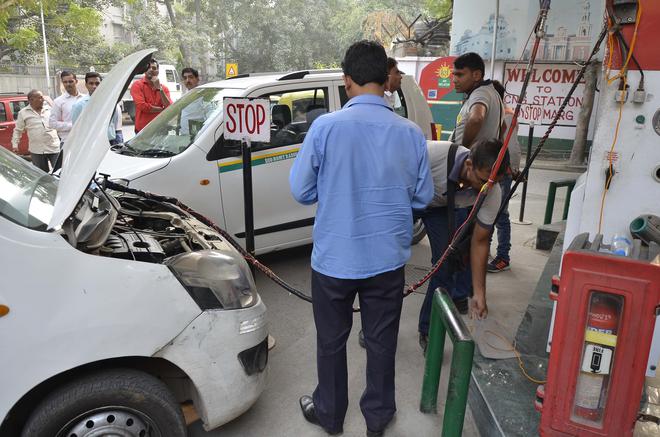Mounting vehicular pollution in Bengaluru has intensified demands to accelerate the ‘electric’ switch to green mobility. But the costly transition has been slow and unsteady. Why has the relatively cheaper Compressed Natural Gas (CNG) failed to take off as an alternative, fuelling both BMTC buses and private, personal vehicles?
Consider this: By 2018, the Gas Authority of India Limited (GAIL) had set up three CNG stations inside the BMTC depots in Hennur, Sumanahalli and Peenya. But they were never used since the transport corporation did not acquire any bus fuelled by CNG. The costly retrofitting of existing buses was out of question.
A GAIL India spokesperson informs that currently, over 35,000 CNG-run vehicles are registered in Bengaluru. These include autorickshaws, cars, light and heavy commercial vehicles. This figure stood at 8,000 in October 2021. Yet, the numbers are only a fraction of the city’s total vehicular population estimated to be well over 1.03 crore.
To accelerate adoption of the cleaner fuel in Bengaluru urban and rural districts, GAIL had launched a special scheme in 2021. It was offered to any individual or organisation buying a new car, autorickshaw, taxi, LCV, HCV or those keen to convert their existing vehicles to CNG. Customers were offered a prepaid CNG fuel card priced at ₹14,000 to ₹25,000. These could be used to fill fuel for free at any of GAIL’s CNG stations in the city.
Yet, the big shift has not happened so far and the narrative is driven by electric vehicles. This, despite the fact that BMTC finds acquiring e-buses prohibitively expensive at almost ₹2 crore per vehicle. At last count, the transport corporation is all set to procure 921 low-floor e-buses, rolling out batches of 100 each month from July-end.
Why go for CNG?
But Vinay Sreenivasa from the Bengaluru Bus Prayanikara Vedike questions the very need for BMTC to acquire electric or CNG buses. “BMTC is moving towards BS6 standard, and are phasing out older buses. If you compare diesel BS6 and CNG, there is not much of a difference. So, why should a public transport utility spend so much on retrofitting buses?” he asks.
Electric buses too are an issue, feels Vinay. “EV technology has not stabilised yet. And till it does, I don’t see why BMTC should be burdened with running it. It is too costly. You have to do an overall cost benefit and life cycle analysis for electric / CNG buses. That is the scientific way to look at it. How much will BMTC have to spend? It is not just about emission at the bus level. Without these questions being answered, why should BMTC move to CNG?”
The focus, he says, should be on private cars. “Push them to use CNG. Lakhs of cars, run on petrol and diesel, are being added to the city. No questions to them, but BMTC which operates around 6,500 buses to transport lakhs of people has to face these questions! First look at the cars if the issue is cutting pollution,” asserts Vinay.

Benefiting from CNG corridor
The GAIL spokesperson draws attention to a tourist CNG corridor that has developed just outside Bengaluru. BMTC, she feels, could benefit from this ecosystem. Mysuru with its Atlantic, Gulf & Pacific Company (AG&P) CNG stations, Tumakuru with MeghaGas-run stations, Ramanagaram with Maharashtra Natural Gas Limited (MNGL) and Dakshina Kannada with GAIL have all developed the necessary infrastructure. “CNG is now an inter-city fuel as well,” she notes.
But Vinay wonders how this can help BMTC. He elaborates, “The real issue is the need for more buses to cater to a population of over 1.3 crore. Ultimately, you need more people to take the bus. Pollution will reduce if the cars reduce and people shift to buses, not by BMTC moving to CNG and electric. Why is the bus only such a big target?”
NGT petition
He attributes the grossly inadequate bus numbers in the city to a petition filed before the National Greens Tribunal (NGT), insisting that BMTC acquire only CNG buses. “In fact, that petition was motivated. And, because of that petition, Bengaluru could not get more buses. Government had the money then to purchase more buses,” he recalls.
In 2016-17, BMTC had proposed to purchase 1,500 diesel engine (BS IV compliant) buses to boost the corporation’s ageing fleet. It bought 500 buses under the Atal Mission for Rejuvenation and Urban Transformation (AMRUT) scheme, but the procurement of the remaining 1,000 buses was stalled by the NGT stay order issued after the petition.
A Noida-based think tank finds Indian cities currently overburdened with metro and EV infrastructure projects, and expanding CNG infrastructure would incur massive capital expenditure. “It is not feasible for cities such as Bengaluru and Mumbai to bear the additional expenses in terms of high taxes,” a resource person there notes, preferring anonymity.
Pitching for electric and not CNG, the expert explains: “As per the government-owned Convergence Energy Services Ltd (CESL) estimates, the per-km cost of electric buses is 23–27% lower without the subsidy than that of CNG buses. With the subsidy, the per-km cost is 31–35% lower than that of CNG buses. Operating and maintenance costs are also relatively lower for electric buses than for CNG buses. So, using CNG buses as an alternative to electric buses in public transportation might not be a wise choice.”
But the Karnataka Government has never given up on CNG buses. In September 2021, the then Transport Minister B Sriramulu had unveiled plans to convert some diesel BMTC buses to CNG to stem losses incurred by the road transport corporations. He had cited the low operating costs of CNG buses in Delhi relative to diesel vehicles.
Learning from auto drivers
Independent mobility analyst Sathya Arikutharam feels BMTC should have a long-term strategy to decide what it should go for: Electric or CNG or stay with diesel buses. “Currently, they are broke and don’t have any financial capacity for capital investment. They make decisions based on the subsidies available. If someone is willing to pay, they will buy CNG, electric or whatever,” he says.
BMTC, as Sathya emphasises, should learn from the city’s autorickshaw drivers. “Over the last 10 years, they have shifted from petrol / diesel to LPG and CNG. They are now delaying a switch to electric autos because they have already put their money in cleaner fuel. They are taking a very commercially viable decision.”
Capital investment decisions, he says, are always based on assets owned, assets required and the options available. “Auto drivers say they have their eco-friendly assets - CNG / LPG. At the end of the life cycles of these assets, they would again make a comparison, and if electric is favourable then, they would go for it. It is as simple as that,” he explains.
BMTC should take a similar decision. Elaborating, he says, “The Corporation now has its diesel buses. It should look at the choices available in the next CapEx cycle and the trajectory towards EV transition. It should decide whether to move directly to EV or actually take a CNG path because it is affordable and then wait for EV technology to mature. It could be a mix of both.”







